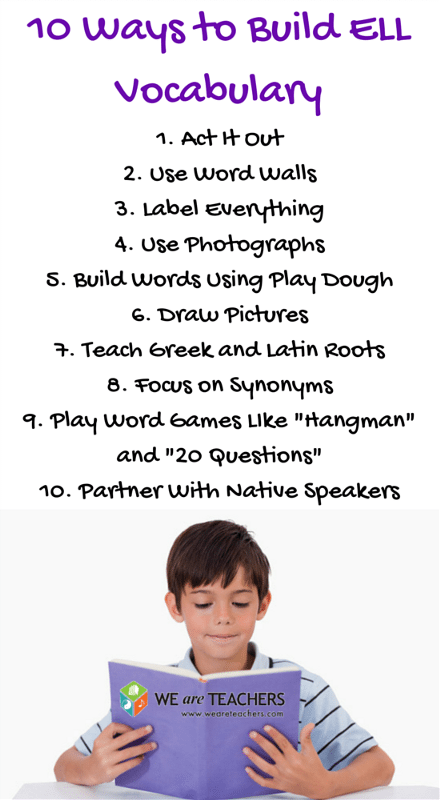This article is the first in a two-part series on supporting ELL literacy, sponsored by Middlebury Interactive Languages.
If you teach English-language learners, you know what a challenge it can be to keep vocabulary instruction fresh and engaging. That’s why we recently asked educators in our WeAreTeachers Helpline group to share their favorite ways for growing ELL vocabulary in middle school. Here’s what they had to say:
Act it out: Shake up your usual vocabulary routine and get students out of their seats by playing a game of vocabulary charades. Write the words that you want to practice on index cards, and invite teams to take turns choosing a card and acting out the word.
Use word walls: Middle schoolers aren’t too old for word walls! Try creating different walls or display areas based on some of their favorite topics (e.g., sports or movies) or categories related to surviving middle school (friendship words, cafeteria words).
Label everything: When you have English-language learners in your classroom, everything from your stapler to your pencil sharpener to your wall clock should be labeled. Get students involved: Have them create labels by cutting out and collaging pictures and words from magazines.
Use photographs: Written routines should include photographs to help reinforce the vocabulary words at hand. If you post instructions for turning in homework, for example, include a photograph of a student acting out each step.
Build words using play dough: Teacher Jill T. recommends giving each student a small container of play dough. Choose a vocabulary word, and challenge all students to make something that represents the word in under one minute. “Pick a winner from each side of the room, who then act as judges for the next round,” says Jill. “Seventh and eighth graders still love play dough!”
Draw pictures: When learning new words, have students illustrate their own pictures or representations of the word. This combination of visual and verbal exercises can help kids retain new words more quickly. A fun variation is to have students make comic strips or books featuring their new vocabulary.
Teach Greek and Latin roots: It may be old-school, but there’s no doubt that teaching word roots and origins is a fast path to understanding entire word families. Try having students create flow charts with the root at the top and all of the related words below. Or invite students to write a song explaining a word root and related vocabulary.
Focus on synonyms: Teaching synonyms is another quick way to build vocabulary in a deep, meaningful way. “If they have learned ‘emblem,’ they should also know ‘emblematic’ and ‘badge,’ ‘banner,’ ‘coat of arms,’ etc.” says teacher Krista C.
Play word games: Word games like Hangman and 20 Questions are great for gaining English-language skills and reviewing concepts in your curriculum too. Try playing Ancient Egypt 20 Questions for example, where all the answers tie in to your study of that time period.
Partner with native speakers: You might ask students “what 20 words do you think all middle schoolers should know?” and have native speakers partner with English-language learners to create a presentation sharing their choices.
Want more support for your English-language learners? Find out more about Middlebury Interactive’s exciting new curriculum focused on closing the ELL achievement gap.


